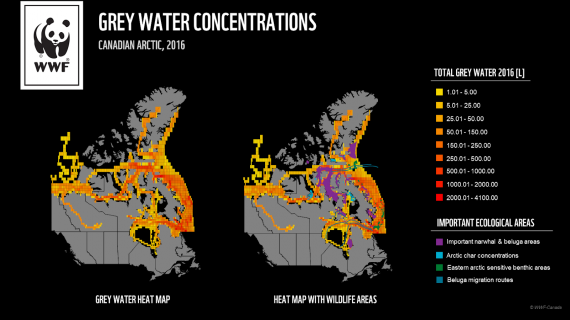Grey water dumped into Nunavut waters is set to double by 2035, says WWF
The dramatic increase is linked to an increase in ship traffic in the region.

The amount of grey water dumped from ships into northern waters could double by the year 2035, if Transport Canada doesn’t work on its Arctic pollution regulations.
That’s according to a nearly 50-page study released last week, on Aug. 15, by the World Wildlife Foundation.
Grey water is run-off waste water from kitchens and laundry done on board ships. Grey water does not contain sewage.
This doubling of projected dumping is linked to a rise in ship traffic within northern waters.
These vessels include cruise ships and other vessels carrying tourists, commercial ships carrying sealift supplies and fuel to communities, and ships supplying mines or hauling ore.
It’s large passenger cruise ships that will cause the largest increase in grey water discharge, the study says. As a primary tourism attraction, routes along the Northwest Passage will be most at risk of dumping.
And because those vessels visit northern communities and search for wildlife, what the WWF calls “hot spots” for grey water dumping often overlap with whale habitats like calving areas and migration routes, or with areas where fishing and harvesting is done for char and shellfish.
“Contamination of fish and shellfish threatens food security in northern communities,” a release by WWF said.
Other vessels are to blame, too.
“Ships used for mining exports and fishing spend much more time in the Arctic, so even though they have fewer people on board and lower levels of water use, they are also large contributors,” the release said.
About 250 liters (about 66 gallons) of grey water are made each day per person on a passenger vessel and 125 liters (33 gallons) per person each day on a cargo vessel, the study estimates.
Right now, Canada’s pollution prevention law for Arctic waters does prohibit dumping of waste, but does not mention “permissible sewage” like grey water.
“This puts the onus on the operator to prove that grey water does not include any deleterious waste … which is extremely difficult,” the study says.
That’s because there are no Transport Canada-approved systems or certifications mandated for grey-water treatment in the Arctic.
“It has been generally known that while grey water discharge is in theory prohibited, in practice it has not been monitored or enforced due to the lack of any practical alternatives.”
While Canada’s regulations request that ships treat and discharge grey water before entering no dump zones, for a ship spending any length of time in the Arctic this would mean having a very large holding tank.
The WWF wants tougher regulations.
“Transport Canada rules for grey water are much more stringent for waters below the 60th parallel,” the WWF’s news release said. “Although the impacts of grey water are similar to sewage, ships passing through Arctic waters in Canada are not required to adhere to any specific regulations for grey water and ships are not monitored for dumping this harmful waste into the sea.”
Grey water dumping can also introduce invasive species, metals, bacteria and microplastics to Arctic waters, said Melissa Nacke, the WWF’s Arctic shipping and marine conservation specialist.
“It doesn’t make any sense that the fragile Canadian Arctic environment receives less regulation and protection than southern waters and neighbouring Alaska, and we want that to change.”
The WWF study calls for more research into less harmful chemicals used to treat waste water, a survey of current practices of vessel operators for treating and discharging grey water, and for the creation of a plan to monitor and enforce regulations for how vessels are discharging grey water in the Arctic.
This isn’t the first time the WWF has pushed for heavier regulations for the discharge of grey water in the North.
The WWF wanted Transport Canada to up its game on grey-water regulations when the federal government implemented its own version of international marine regulations called the Polar Codein January. The group is also lobbying to have heavy fuel oil banned in the Arctic.
The WWF’s hope is that heavy fuel oil and grey-water discharge will be dealt with in a second phase of Polar Code regulations to be introduced in Canada. One hoped-for regulation is that ships would not be allowed to dump treated grey water near land-fast or shelf ice.